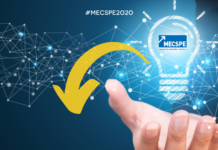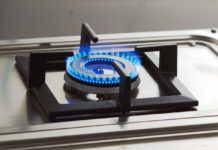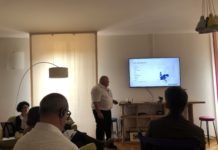
The conformal coating is the coating process of electronic boards by means of a subtle layer of synthetic resin, to assure their protection against all those environmental factors that might prove noxious for the good operation of household appliances.

The target of the conformal coating process is generally to provide a consistent protection against the various environmental factors that might negatively influence the operation of electronic devices. Wetness, dust and pollutants are the most recurring in household appliances. Some of the resins used can also increase the protection against repeated thermal cycles, mechanical shocks and vibrations.
It is important to define correctly the formulation of the resin to be used for coating, the selection should not occur only in the ambit of the most popular materials but we should assess solutions that, providing the same final result, might increase the productive efficiency and optimize costs. They are generally defined in design phase, before undertaking the board production.
In the process study, we must consider all the different variables that intervene in characterizing it: quantity of boards to be processed, desired productivity, type of required protection (total or partial), material type, system to be adopted and available budget.
We should also consider that in some cases it is necessary to proceed to an accurate board cleaning before subjecting it to the conformal coating process, in relation to the flux used. It might happen that a formulation for coating containing solvent interacts with the residues of welding paste, thus affecting its reliability.

Coating materials
The material choice cannot set aside the knowledge of the environmental conditions in which the PCB will operate: wetness, maximum temperature value, presence of dust and polluting substances are the variables worth considering.
Today the market offers a broad range of possible choices of protection materials, which can be grouped into five families:
Acrylic – Easily applied and with excellent protection against humidity. On the other hand, they do not offer great resistance either to chemical agents or high performances at high temperatures
Polyurethanes – They are characterized by excellent resistance to chemical agents and wetness but they need longer curing times (polymerization) and are hardly removed to execute the re-processing
Silicon – With very good resistance to high temperatures, they are excellent for the vibration damping. Quite difficult removal in case of re-processing and scarcely suitable for the protection against wetness
Water-based resins – They are “green” products due to the absence of solvents (VOC-free) and then innocuous for operators and environment. As drawback, they need long drying times and specific equipment to reach an adequate drying
Epoxy – Excellent resistance to chemical agents; generally very sturdy but hardly reprocessed and with scarce capability of compensating the CTE (Coefficient of Thermal Expansion) owing to thermal shocks
UV Curable – Very fast drying times, very resistant to whatever environmental condition, hardly reprocessed and involving expensive processing since they need special UV furnaces for curing.

Like in all manufacturing processes, the cost of materials constitutes a determinant factor in their choice. Today the technological research provides various prices for the same product, an economic advantage from which to benefit if particular certifications or approvals are not required.
To allow controlling that the deposit has correctly taken place and is homogeneous, resins integrate fluorescent particles activated when they are radiated by Wood light (black light). The control can be performed manually in apposite cabins or with automated optical inspection systems.
The process
The coating process rests on very precise physical bases, where the surface tension of materials, viscosity, rheological characteristics and dispensing speed influence the final precision.
We can approximately subdivide the process into two phases. In the first one, the assembled PCB is coated with the protective resin layer; in the second step, the PCB undergoes the polymerization, operation that crystallizes the resin so that the latter forms a single body with the substrate and the components, totally insulating the whole from the external world. This second phase can also occur at environmental temperature but times are much longer than in the furnace execution. Some materials require the infrared as activation energy, others the ultraviolet.
The coating process by dipping can be executed manually by the operator that plunges the PCB into the tank containing the resin or, alternatively, with a robotic system that transports inside and outside the bath the PCB to be coated, improving the productivity and partly the repeatability. There are sometimes components (for instance connectors, LED or switches) or other areas on which to avoid the resin treatment, and in this case they must be masked before dipping; the mask is removed once occurred the polymerization and it must be disposed as special waste since contaminated by the resin.
The dipping process implies some drawbacks such as the uncontrolled coating thickness, the bath contamination with the consequent viscosity variation, the cleaning of process systems and the exposure of the working environment to the presence of VOC.
Another method often used is the manual spraying of the coating material on the board, or through apposite cans or with a spray gun. It is affected by problems resembling the previous ones, low efficiency included; it has in fact various repeatability and precision contraindications, the deposited thickness is not uniform and it strongly depends on operators’ skilfulness.
It is economically disadvantageous since the wide spray cone generates the dispersion of much material, not to mention the risks for the operator’s health.
With the purpose of improving the process qualitatively and productively, they have introduced selective conformal coating systems that, through the use of fixtures, have allowed eliminating the manual masking. Available both in line and in batch configuration, they use a mechanical mask that limits the resin access to the only zones to be coated; the output is high and the good process repeatability does not depend on the operator’s competence. The drawback consists in the need of producing fixtures for each different type of PCB.
They have then introduced robotic dispensing systems, composed by three-five axes, equipped with one or more valves and configured in line or with manual PCB loading and unloading. The characteristics of the coating material, the dispensing valve and the robot’s working speed share in determining the coating thickness.
Highlight of this technology is allowing the coating deposition only where its presence is required and in the desired thickness.
The advantages of the selective dispensing are manifold: from the application of uniform doses and with controlled thicknesses to the process repeatability, from the notable material saving to the productivity increase.
The curing system depends on the resin type used and the desired productive levels. It can be a furnace in-line or a ventilated cabinet, the energy needed for the polymerization generally comes from infrared radiation, with or without hot air convection, or, in case of particular resins, from ultraviolet rays.
For the material that polymerizes under UV rays, furnaces use mercury lamps or UV LED lamps. Concerning acrylic, epoxy, polyurethane and silicon resins, the furnace operates with IR emissions and convection. Various models are available, which vary according to the tunnel length (from 2000 to 5000mm on average) and number of zones.
Batch processes exploit ventilated drying cabinets
A scalable and flexible system
The German Rehm has implemented Protecto, a highly flexible dispenser that can operate in-line or in stand-alone configuration. Thanks to its scalability, the easy programming and the operational flexibility, it can be equipped to satisfy the management of one or more products simultaneously. In fact, it is possible to mount on the head up to 4 valves that can operate with several different resins on the same PCB, or alternatively, on four circuits on the machine.
To work on four different circuits (maintaining the same distance) it is possible to adjust the axis distance among the four valves. The total dispensing area reaches 620mm x 508mm.
Protecto is a selective dispenser also in presence of high components or needing the liquid penetration under their body.
The Stream-Coat nozzle, compatible with all conventional resins, with both low and high viscosity, has an external diameter of just 2.4mm and a length of as many as 100mm to approach the PCB as much as possible, irrespective of the component height.
It is the only valve that can operate in different modalities:
Dispensing style, with continuous and uniform material deposit, leaves precise and well-delimited edges.
When set in micro-spray function, it works on broad area, but with extreme precision.
The jetting mode, with the fast alternation of the valve opening and closing, deposits up to 120 small drops per second.
With a different kind of valve, it is possible to execute the deposition with curtain geometry; working at high speed, it deposits a layer of resin with insignificant dispersion around. In all cases, the deposited film is homogeneous and can be applied, acting on the airflow regulation, close to or under the component body, and it can reach shadow zones as well, without inclining the head.
If you want to deposit silicon, stripping and thermo-conductive compound, the material must be introduced into apposite pressurized cartridges.
For the programming, is loaded in background the board image, on which the operator sets the areas to be covered by tracing lines or geometrical figures. Entering then the product page, you input the data concerning the coating material and the valve type.



